Folded Spiral Resonator with Double-Layered Structure for Near-Field Wireless Power Transfer
Abstract
:1. Introduction
- (a)
- Coupler with the capability of coupling:
- (b)
- Coupler with the capability of coupling and imaginary-part impedance matching
- (c)
- Coupler with the capability of coupling and conjugate impedance matching
2. Principle of the Folded Structure
3. Simulation Models
4. Results
4.1. Impedance Matching by the Folded Structure
4.2. Comparison
5. Comparison with the Conventional Structure
- (a)
- Short-type single-layered spiral
- (b)
- Short-type double-layered spiral
- (c)
- Open-type double-layered self-resonant spiral
- (d)
- Folded spiral with a double-layered structure
Consideration Model
6. Conclusions
Author Contributions
Funding
Conflicts of Interest
References
- Hui, S.; Zhong, W.; Lee, C. A Critical Review of Recent Progress in Mid-Range Wireless Power Transfer. IEEE Trans. Power Electron. 2014, 29, 4500–4511. [Google Scholar] [CrossRef] [Green Version]
- Kim, H.-J.; Hirayama, H.; Kim, S.; Han, K.J.; Zhang, R.; Choi, J.-W. Review of Near-Field Wireless Power and Communication for Biomedical Applications. IEEE Access 2017, 5, 21264–21285. [Google Scholar] [CrossRef]
- Imura, T.; Okabe, H.; Hori, Y. Basic Experimental Study on Helical Antennas of Wireless Power Transfer for Electric Vehicles by using Magnetic Resonant Couplings. IEEE Veh. Power 2009, 832–836. [Google Scholar]
- Ahn, S.; Pak, J.; Song, T.; Lee, H.; Byun, J.G.; Kang, D.; Choi, C.S.; Kim, E.; Ryu, J.; Kim, M.; et al. Low Frequency Electromagnetic Field Reduction Techniques for the On-Line Electric Vehicle (OLEV). In Proceedings of the 2010 IEEE International Symposium on Electromagnetic Compatibility, Fort Lauderdale, FL, USA, 25–30 July 2010; pp. 625–630. [Google Scholar] [CrossRef]
- Eghtesadi, M. Inductive Power Transfer to an Electric Vehicle-Analytical Model. In Proceedings of the 40th IEEE Vehicular Technology Conference, Orlando, FL, USA, 6–9 May 1990; pp. 100–104. [Google Scholar] [CrossRef]
- Huang, C.C.; Lin, C.L.; Wu, Y.K. Simultaneous Wireless Power/Data Transfer for Electric Vehicle Charging. IEEE Trans. Ind. Electron. 2017, 64, 682–690. [Google Scholar] [CrossRef]
- Bashirullah, R. Wireless Implants. IEEE Microw. Mag. 2010, 11, S14–S23. [Google Scholar] [CrossRef]
- RamRakhyani, A.K.; Mirabbasi, S.; Chiao, M. Design and Optimization of Resonance-Based Efficient Wireless Power Delivery Systems for Biomedical Implants. IEEE Trans. Biomed. Circ. Syst. 2011, 5, 48–63. [Google Scholar] [CrossRef] [PubMed]
- Ben Amar, A.; Kouki, A.B.; Cao, H. Power Approaches for Implantable Medical Devices. Sens. Basel 2015, 15, 28889–28914. [Google Scholar] [CrossRef] [PubMed]
- Jow, U.M.; Ghovanloo, M. Design and Optimization of Printed Spiral Coils for Efficient Transcutaneous Inductive Power Transmission. IEEE Trans. Biomed. Circ. Syst. 2007, 1, 193–202. [Google Scholar] [CrossRef] [PubMed]
- Kiani, M.; Jow, U.M.; Ghovanloo, M. Design and Optimization of a 3-Coil Inductive Link for Efficient Wireless Power Transmission. IEEE Trans Biomed. Circ. Syst. 2011, 5, 579–591. [Google Scholar] [CrossRef] [Green Version]
- Shinohara, N. History of Research and Development of Beam Wireless Power Transfer4. In Proceedings of the 2018 IEEE Wireless Power Transfer Conference (WPTC), Montreal, QC, Canada, 3–7 June 2018; pp. 1–4. [Google Scholar] [CrossRef]
- Kurs, A.; Karalis, A.; Moffatt, R.; Joannopoulos, J.D.; Fisher, P.; Soljacic, M. Wireless power transfer via strongly coupled magnetic resonances. Science 2007, 317, 83–86. [Google Scholar] [CrossRef] [Green Version]
- Aldhaher, S.; Luk, P.C.K.; Whidborne, J.F. Electronic Tuning of Misaligned Coils in Wireless Power Transfer Systems. IEEE Trans. Power Electron. 2014, 29, 5975–5982. [Google Scholar] [CrossRef] [Green Version]
- Seo, D.W.; Lee, J.H.; Lee, H.S. Optimal Coupling to Achieve Maximum Output Power in a WPT System. IEEE Trans. Power Electron. 2016, 31, 3994–3998. [Google Scholar] [CrossRef]
- Sato, M.; Yamamoto, G.; Gunji, D.; Imura, T.; Fujimoto, H. Development of Wireless In-Wheel Motor Using Magnetic Resonance Coupling. IEEE Trans. Power Electron. 2016, 31, 5270–5278. [Google Scholar] [CrossRef]
- Smeets, J.P.C.; Overboom, T.T.; Jansen, J.W.; Lomonova, E.A. Comparison of Position-Independent Contactless Energy Transfer Systems. IEEE Trans. Power Electron. 2013, 28, 2059–2067. [Google Scholar] [CrossRef]
- Chen, Q.; Ozawa, K.; Yuan, Q.W.; Sawaya, K. Antenna Characterization for Wireless Power-Transmission System Using Near-Field Coupling. IEEE Antennas Propag. Mag. 2012, 54, 108–116. [Google Scholar] [CrossRef]
- Kim, J.; Son, H.C.; Kim, K.H.; Park, Y.J. Efficiency Analysis of Magnetic Resonance Wireless Power Transfer With Intermediate Resonant Coil (vol 10, pg 389, 2011). IEEE Antennas Wirel. Propag. Lett. 2011, 10, 1609. [Google Scholar] [CrossRef]
- Yuan, Q.W.; Chen, Q.; Li, L.; Sawaya, K. Numerical Analysis on Transmission Efficiency of Evanescent Resonant Coupling Wireless Power Transfer System. IEEE Trans. Antennas Propag. 2010, 58, 1751–1758. [Google Scholar] [CrossRef]
- Poon, A.S.Y.; O’Driscoll, S.; Meng, T.H. Optimal Frequency for Wireless Power Transmission Into Dispersive Tissue. IEEE Trans. Antennas Propag. 2010, 58, 1739–1750. [Google Scholar] [CrossRef] [Green Version]
- Haus, H.A.; Huang, W. Coupled-mode theory. Proc. IEEE 1995, 79, 1505–1518. [Google Scholar] [CrossRef] [Green Version]
- Kiani, M.; Ghovanloo, M. The Circuit Theory Behind Coupled-Mode Magnetic Resonance-Based Wireless Power Transmission. Ieee Trans. Circuits Syst. I 2012, 59, 2065–2074. [Google Scholar] [CrossRef]
- Hirayama, H.; Amano, T.; Kikuma, N.; Sakakibara, K. An Investigation on Self-Resonant and Capacitor-Loaded Helical Antennas for Coupled-Resonant Wireless Power Transfer. IEICE TRANS. Commun. 2013, 96, 2431–2439. [Google Scholar] [CrossRef]
- Hirayama, H.; Ozawa, T.; Hiraiwa, Y.; Kikuma, N.; Sakakibara, K. A consideration of electro-magnetic-resonant coupling mode in wireless power transmission. IEICE Electron. Express 2009, 6, 1421–1425. [Google Scholar] [CrossRef] [Green Version]
- Seo, D.W.; Lee, J.H.; Lee, H.S. Study on Two-Coil and Four-Coil Wireless Power Transfer Systems Using Z-Parameter Approach. ETRI J. 2016, 38, 568–578. [Google Scholar] [CrossRef] [Green Version]
- Fotopoulou, K.; Flynn, B.W. Wireless Power Transfer in Loosely Coupled Links: Coil Misalignment Model. IEEE Trans. Magn. 2011, 47, 416–430. [Google Scholar] [CrossRef]
- Kim, J.; Son, H.C.; Park, Y.J. Multi-loop coil supporting uniform mutual inductances for free-positioning WPT. Electron. Lett. 2013, 49, 417–419. [Google Scholar] [CrossRef]
- Kim, H.; Song, C.; Kim, D.H.; Jung, D.H.; Kim, I.M.; Kim, Y.I.; Kim, J.; Ahn, S.; Kim, J. Coil Design and Measurements of Automotive Magnetic Resonant Wireless Charging System for High-Efficiency and Low Magnetic Field Leakage. IEEE Trans. Microw. Theory Tech. 2016, 64, 383–400. [Google Scholar] [CrossRef]
- Hirayama, H.; Amano, T.; Kikuma, N.; Sakakibara, K. A consideration of open- and short-end type helical antennas for magnetic-coupled resonant wireless power transfer. In Proceedings of the 2012 6th European Conference on Antennas and Propagation (EUCAP), Prague, Czech Republic, 26–30 March 2012; pp. 3009–3013. [Google Scholar] [CrossRef]
- Nakamura, K.; Hirayama, H. On a Transmission Efficiency of Tape-wound Spiral Antenna for Coupled Resonant Wireless Power Transfer. In Proceedings of the 2016 International Symposium on Antennas and Propagation (Isap), Okinawa, Japan, 24–28 Octobr 2016; pp. 528–529. [Google Scholar]
- Hirayama, H.; Ando, M.; Sonobe, T. Suppression of Common-mode Radiation Using Folded-spiral Antenna for Wireless Power Transfer. In Proceedings of the 2017 Asia-Pacific International Symposium on Electromagnetic Compatibility (APEMC), Seoul, Korea, 20–23 June 2017; p. 86. [Google Scholar]
- Chou, J.H.; Lin, D.B.; Chen, S.J. Near-Field Coupled Antenna Pair with Transmission Efficiency Enhancement for WPT. In Proceedings of the 2015 Asia-Pacific International Symposium on Electromagnetic Compatibility (Apemc), Taipei, Taiwan, 25–29 May 2015; pp. 275–277. [Google Scholar]
- Ohira, T. Maximum available efficiency formulation based on a black-box model of linear two-port power transfer systems. IEICE Electron. Express 2014, 11. [Google Scholar] [CrossRef] [Green Version]
- Hirayama, H. Unified Coupling and Resonant Model for Near-field Wireless Power Transfer System. In Proceedings of the 2017 IEEE International Conference on Computational Electromagnetics (Iccem), Kumamoto, Japan, 8–10 March 2017; pp. 122–123. [Google Scholar] [CrossRef]
- Hirayama, H.; Komatsu, K.; Yamada, H.; Kikuma, N.; Sakakibara, K. Dielectric Loading Effect of Spiral Tape Antenna for Coupled-resonant Wireless Power Transfer. In Proceedings of the EuCAP 2014, The Hague, The Netherlands, 6–11 April 2014; pp. 2426–2427. [Google Scholar]
- Komatsu, K.; Hirayama, H.; Kikuma, N.; Sakakibara, K. Far-field Radiation and Near-field Leakage of Self-resonant Spiral Antennas for Coupled-resonant Wireless Power Transfer. In Proceedings of the 2013 International Symposium on Electromagnetic Compatibility, Brugge, Belgium, 26 September 2013; pp. 883–886. [Google Scholar]
- Komatsu, K.; Hirayama, H.; Kikuma, N.; Sakakibara, K. A consideration of electric and magnetic coupling coefficient of spiral antenna for wireless power transfer. In Proceedings of the 2012 International Symposium on Antennas and Propagation (ISAP), Nagoya, Japan, 29 October–2 November 2012; pp. 170–173. [Google Scholar]
- Huang, R.H.; Zhang, B. Frequency, Impedance Characteristics and HF Converters of Two-Coil and Four-Coil Wireless Power Transfer. IEEE J. Emerg. Select. Top. Power Electron. 2015, 3, 177–183. [Google Scholar] [CrossRef]
- Moon, S.; Moon, G.W. Wireless Power Transfer System With an Asymmetric Four-Coil Resonator for Electric Vehicle Battery Chargers. IEEE Trans. Power Electron. 2016, 31, 6844–6854. [Google Scholar] [CrossRef]
- Zhang, Y.M.; Zhao, Z.M.; Lu, T. Quantitative Analysis of System Efficiency and Output Power of Four-Coil Resonant Wireless Power Transfer. IEEE J. Emerg. Select. Top. Power Electron. 2015, 3, 184–190. [Google Scholar] [CrossRef]
- Huang, S.D.; Li, Z.Q.; Li, Y.; Yuan, X.F.; Cheng, S.Y. A Comparative Study Between Novel and Conventional Four-Resonator Coil Structures in Wireless Power Transfer. IEEE Trans. Magnet. 2014, 50. [Google Scholar] [CrossRef]
- Guertler, R. Impedance Transformation in Folded Dipoles. Proc. IRE 1950, 38, 1042–1047. [Google Scholar] [CrossRef]
- Miyagoshi, H.; Noguchi, K.; Itoh, K.; Ida, J. High-Impedance Wideband Folded Dipole Antenna for Energy Harvesting Applications. In Proceedings of the 2014 International Symposium on Antennas and Propagation (Isap), Kaohsiung, China, 2–5 December 2014; pp. 601–602. [Google Scholar]
- Furuta, T.; Ito, M.; Nambo, N.; Itoh, K.; Noguchi, K.; Ida, J. The 500MHz band low power rectenna for DTV in the Tokyo area. In Proceedings of the 2016 IEEE Wireless Power Transfer Conference (Wptc), Aveiro, Portugal, 6–7 May 2016. [Google Scholar]
- Ando, M.; Hirayama, H. Impedance Matching using Folded Spiral Antenna for Coupled-resonant Wireless Power Transfer. In Proceedings of the 2016 International Symposium on Antennas and Propagation (Isap), Okinawa, Japan, 24–28 October 2016; pp. 56–57. [Google Scholar]

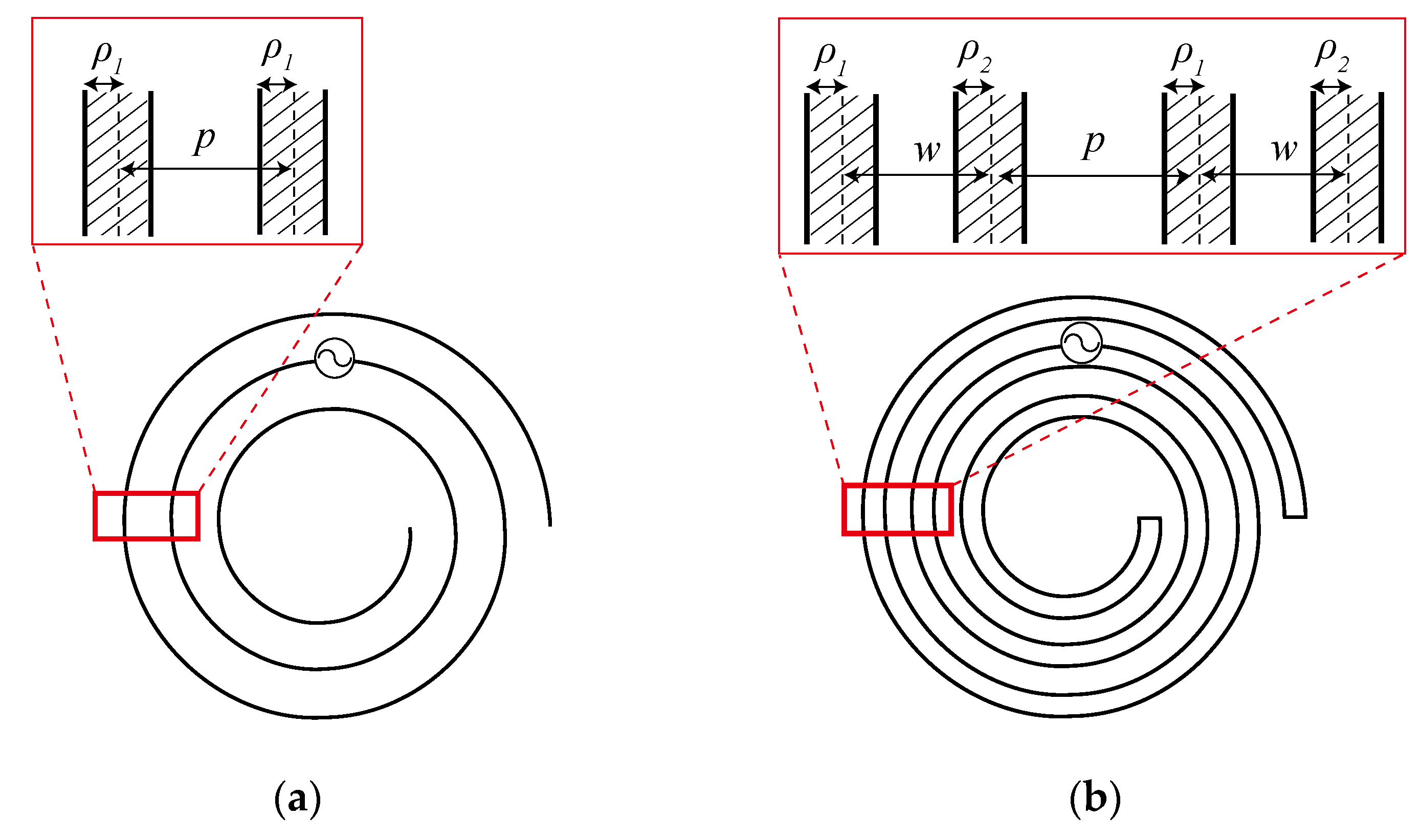
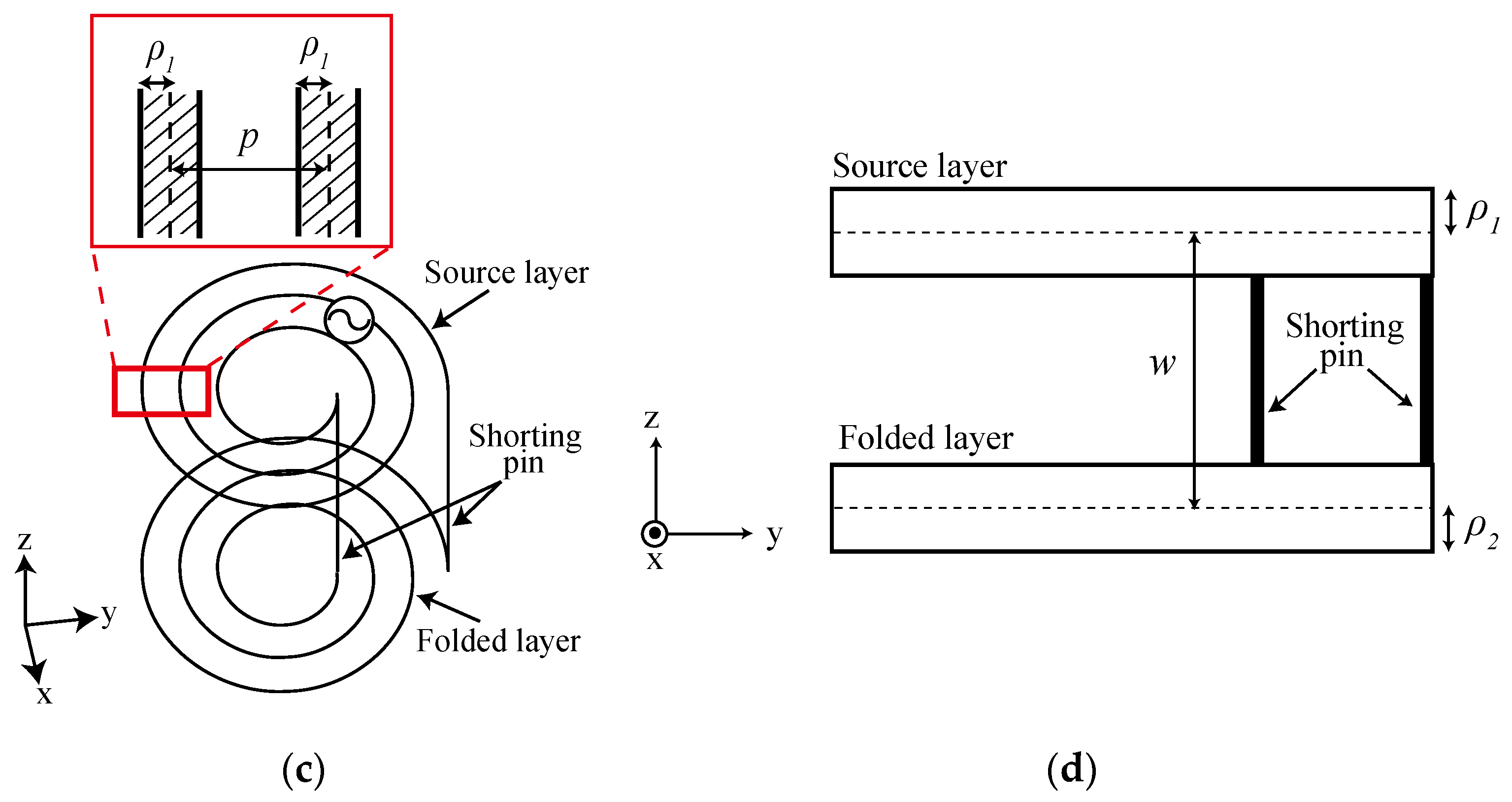
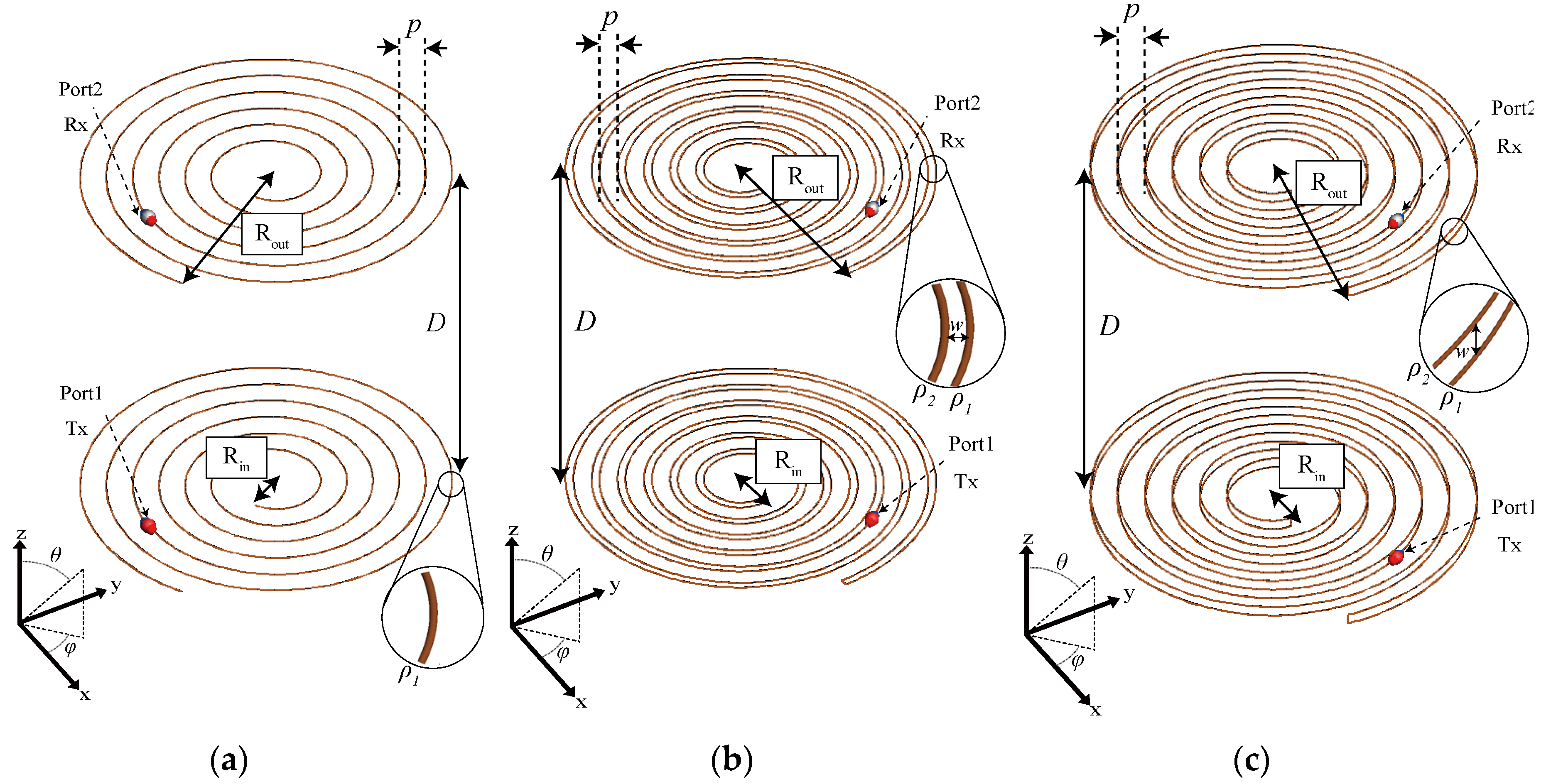
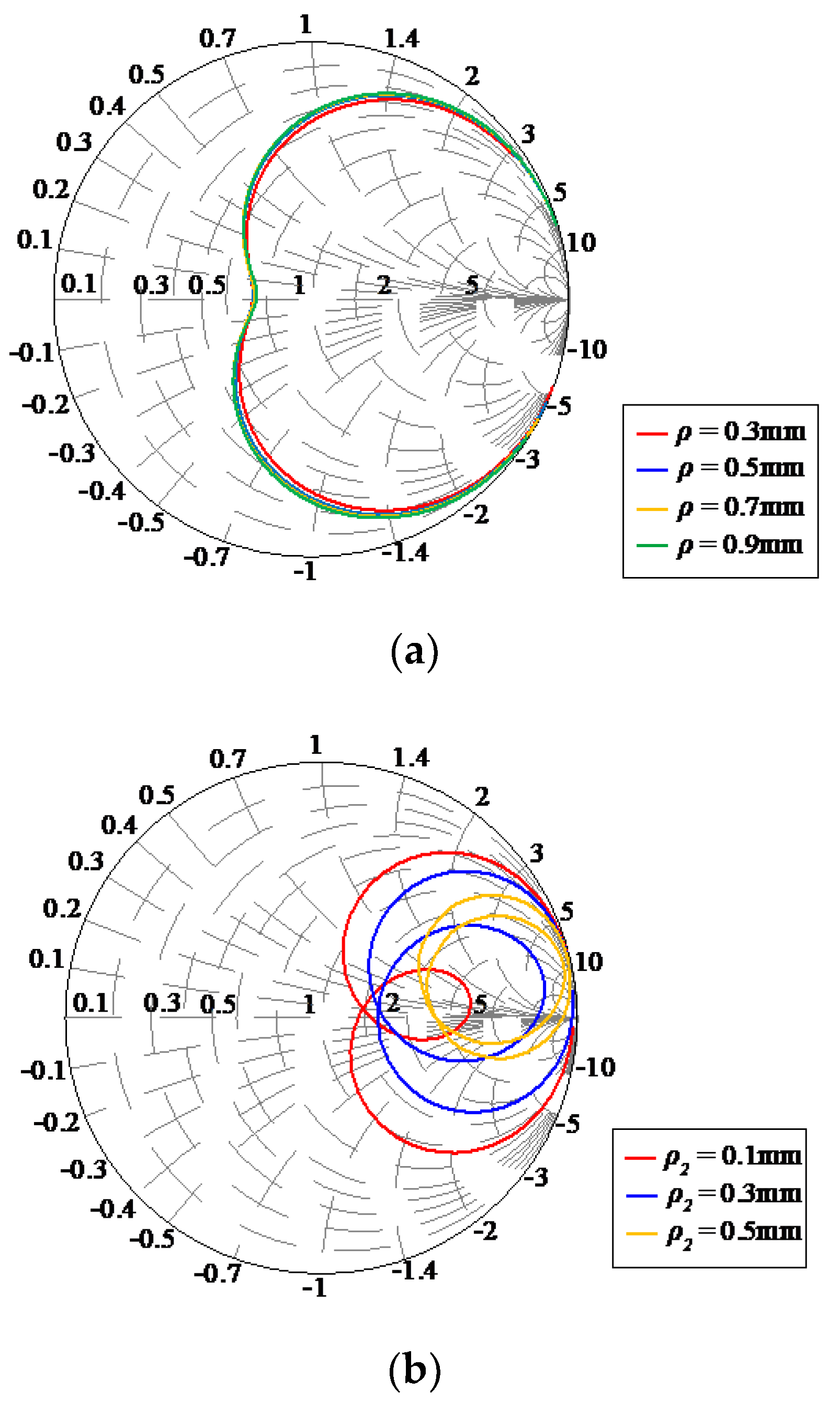
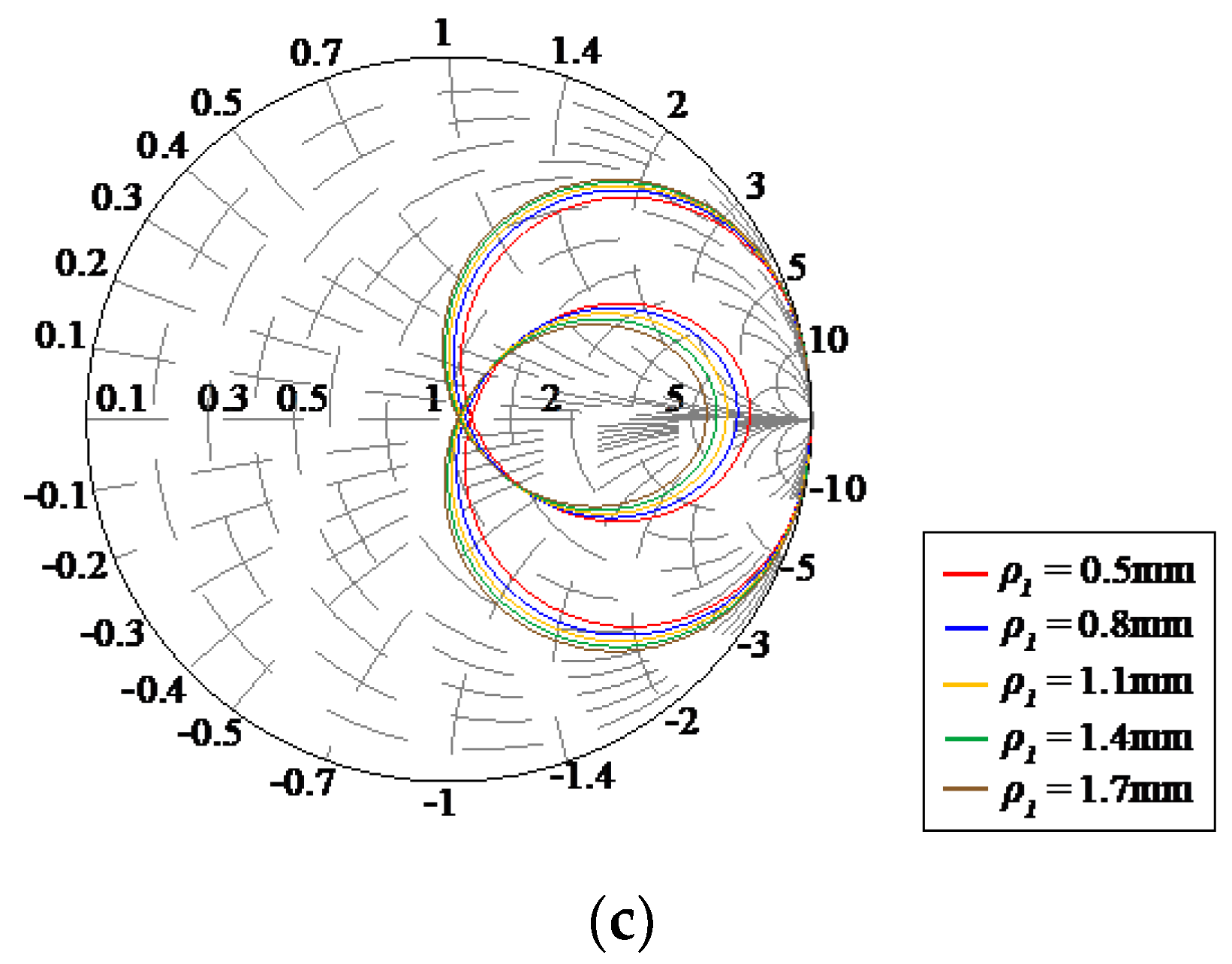

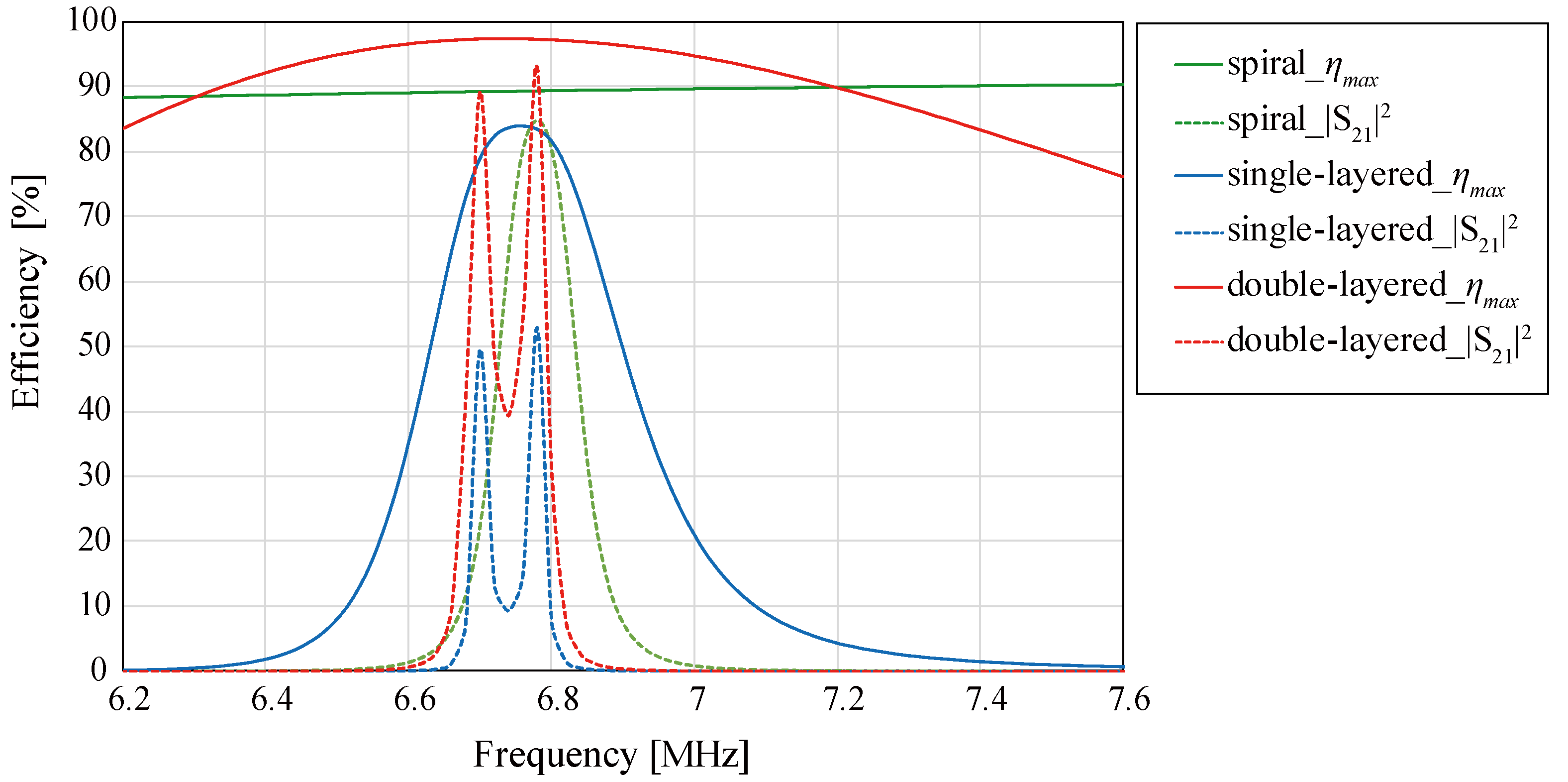
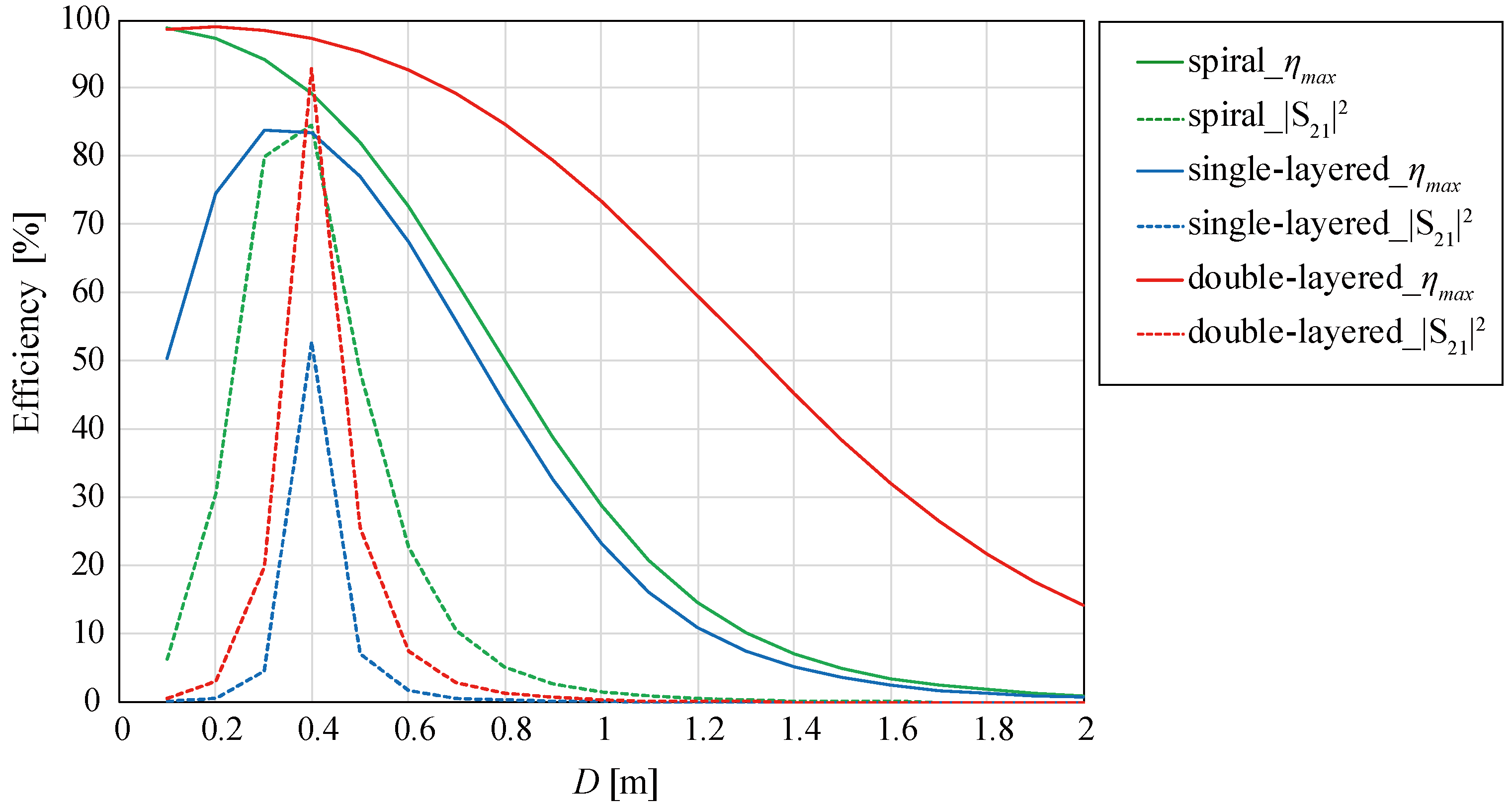

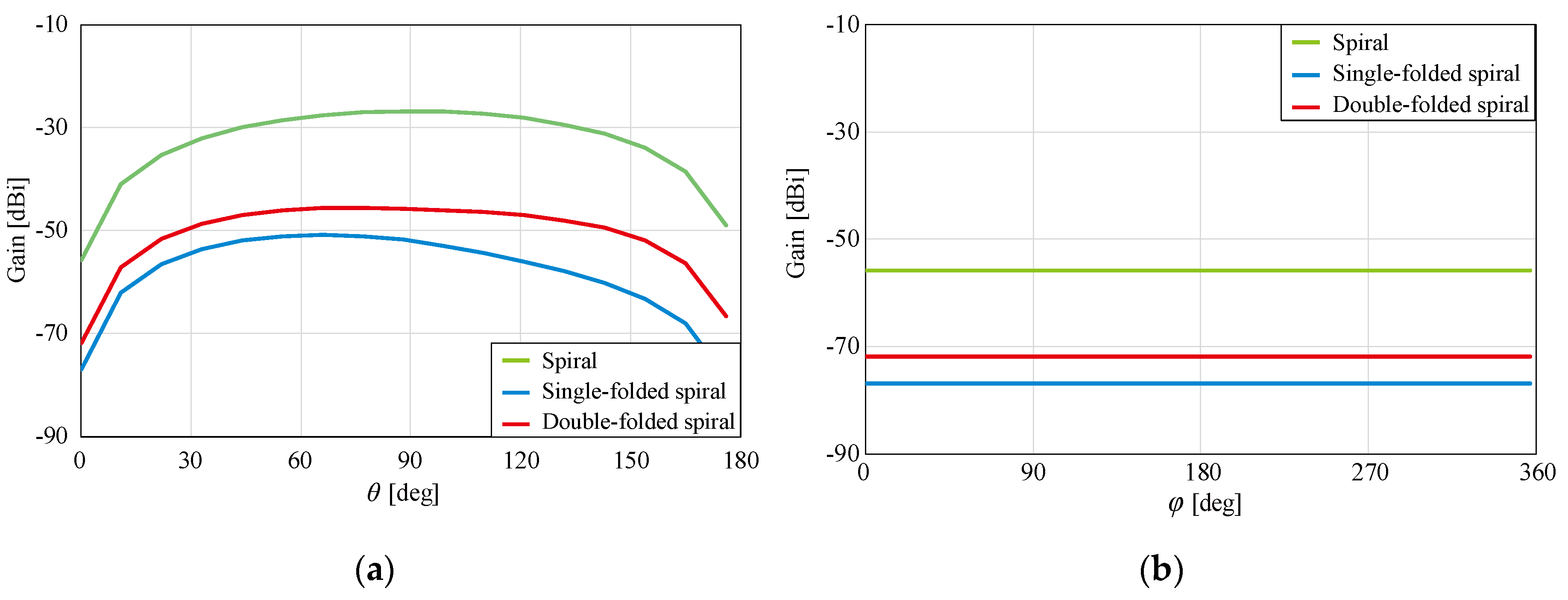


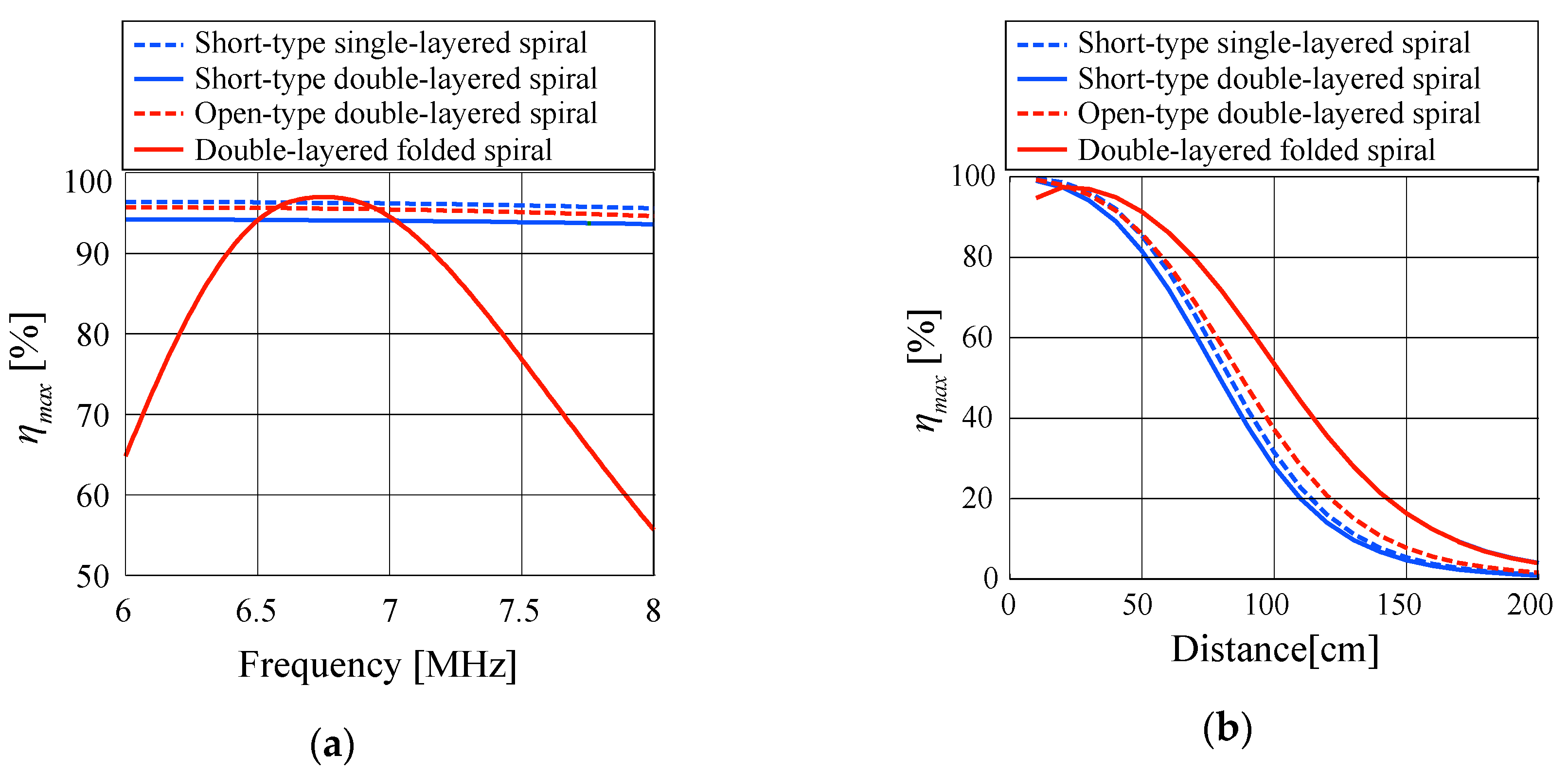
| Parameter | Spiral | Single-Layered Folded Spiral | Double-Layered Folded Spiral |
|---|---|---|---|
| Rout [mm] | 150 | 150 | 150 |
| Rin [mm] | 8.878 | 55.25 | 57.37 |
| N | 33.22 | 23.31 | 21.68 |
| [mm] | 0.5 | 0.3610 | 1.117 |
| [mm] | - | 0.3643 | 1.104 |
| w [mm] | - | 1.236 | 6.776 |
| p [mm] | 3.552 | 2.492 | 2.641 |
| Parameters | Short-Type Single-Layered Spiral | Short-Type Double-Layered Spiral | Open-Type Double-Layered Spiral | Double-Layered Folded Spiral |
|---|---|---|---|---|
| Rout [mm] | 150 | 150 | 150 | 150 |
| Rin [mm] | 32 | 144 | 142 | 95 |
| N | 36 | 5 | 7 | 16 |
| [] | 96.26 | 94.11 | 95.55 | 96.97 |
| kQ product | 52.43 | 32.91 | 43.95 | 664.92 |
| 0.0407 | 0.0778 | 0.0312 | 0.0244 | |
| Q factor | 1288.2 | 423.0 | 1407.3 | 2660.9 |
© 2020 by the authors. Licensee MDPI, Basel, Switzerland. This article is an open access article distributed under the terms and conditions of the Creative Commons Attribution (CC BY) license (http://creativecommons.org/licenses/by/4.0/).
Share and Cite
Arai, T.; Hirayama, H. Folded Spiral Resonator with Double-Layered Structure for Near-Field Wireless Power Transfer. Energies 2020, 13, 1581. https://doi.org/10.3390/en13071581
Arai T, Hirayama H. Folded Spiral Resonator with Double-Layered Structure for Near-Field Wireless Power Transfer. Energies. 2020; 13(7):1581. https://doi.org/10.3390/en13071581
Chicago/Turabian StyleArai, Takaya, and Hiroshi Hirayama. 2020. "Folded Spiral Resonator with Double-Layered Structure for Near-Field Wireless Power Transfer" Energies 13, no. 7: 1581. https://doi.org/10.3390/en13071581





